ISSN ONLINE(2319-8753)PRINT(2347-6710)
ISSN ONLINE(2319-8753)PRINT(2347-6710)
Ravi kumar.M1, Keerthiprasad.K.S2
|
| Related article at Pubmed, Scholar Google |
Visit for more related articles at International Journal of Innovative Research in Science, Engineering and Technology
This paper presents the delamination resistance of Hybrid Composites Laminates made from Hemp and E-Glass. Two different types of laminates were fabricated by hand lay-up technique; (i) hemp fiber epoxy matrix laminates and (ii) E-Glass fiber epoxy matrix laminates. The hybrid composites are more advanced composites in the present world, they have more than one reinforcing phase and a single matrix phase or vice-versa and even possible with multiple reinforcing and multiple matrix phases. This paper brings out the salient features of indigenously developed test equipment for testing localized, penetrating impact on hybrid composite panels. The dimension of the panels in 60*60 mm2 with a typical thickness of 3.6 mm. The impact velocities are in the region 3-7 m/s, with an imp actor mass between 5-10 kg. Using this equipment laminated composites, panels and can be tested to assess the resistance to falling weight in low velocity test.
Keywords |
| Hemp fiber,E-Glass fiber, Inpainting, hand lay-up technique, Low velocity impact test. |
I. INTRODUCTION |
| There is a great increase in the use of hybrid composite materials in structural applications like automotive, marine, aircraft and space structures of their high specific tensile and compressive strengths, good fatigue and corrosion resistance properties [2] i.e., in applications where the impact needs to be considered, like in the civil transportation, it is of fundamental importance to predict the impact resistance of panels. In dealing with laminated composite panels, the behavior of the core and the interface between the face sheet and the core play in the way the impact energy is absorbed. In general, there are three types of impact machines used in experiments, namely: drop-weight impact rig, which is suitable to simulate low velocity impact by a small mass or with a large mass guided of a rail during free fall; pendulum impactor that consists of a steel ball hanging from a string and gas-gun impactor. The impact tester is used to determine some important design parameters like energy to produce damage, peak impact force, energy threshold, and restitution coefficient, material properties, boundary condition and weight and drop height etc. An instrumented impact tester with a free-falling guided mass has been developed and constructed. The impactor mass are variables thus providing a wide range of impact energies [1]. The equipment is capable of accepting a variety of test specimen shapes and size and is especially useful where there is a restriction in size of the specimen to be tested. |
II. EXPERIMENTAL PROCEDURE |
| There is a great increase in the use of hybrid composite materials in structural applications like automotive, marine, aircraft and space structures of their high specific tensile and compressive strengths, good fatigue and corrosion resistance properties [2] i.e., in applications where the impact needs to be considered, like in the civil transportation, it is of fundamental importance to predict the impact resistance of panels. In dealing with laminated composite panels, the behavior of the core and the interface between the face sheet and the core play in the way the impact energy is absorbed. In general, there are three types of impact machines used in experiments, namely: drop-weight impact rig, which is suitable to simulate low velocity impact by a small mass or with a large mass guided of a rail during free fall; pendulum impactor that consists of a steel ball hanging from a string and gas-gun impactor. The impact tester is used to determine some important design parameters like energy to produce damage, peak impact force, energy threshold, and restitution coefficient, material properties, boundary condition and weight and drop height etc. An instrumented impact tester with a free-falling guided mass has been developed and constructed. The impactor mass are variables thus providing a wide range of impact energies [1]. The equipment is capable of accepting a variety of test specimen shapes and size and is especially useful where there is a restriction in size of the specimen to be tested. |
II. EXPERIMENTAL PROCEDURE |
II.I MATERIALS AND SPECIMEN FABRICATION |
| Two different types of laminates were fabricated by hand lay-up technique; (i) hemp fiber epoxy matrix laminates and (ii) E-Glass fiber epoxy matrix laminates. Hand lay-up technique reinforced manufacture low volume with minimum tooling cost. Fabrication process involves each layer of fabric was pre-impregnated with matrix material which is prepared by mixing general purpose LY556 resin and HY951 hardener in the weight ratio of 10:1 respectively and these layers were placed one over the other in the mould with care to maintain practically achieved tolerance on fabric alignment. Casting was cured under light pressure for 2 hours before removal from the mould |
III .MECHANICAL TEST |
III.I Low velocity impact test. |
| Low velocity impact can be defined as events which can be treated as quasi-static, the upper limit of which can vary from one to tens of ms-1 depending on the target stiffness, material properties and the impact or’s mass and stiffness. Impact damage is generally not considered to be a threat in metal structures because, owing to the ductile nature of the material, large amounts of the energy may be absorbed. At yield stress the material may flow for very large strains (up to 20%) at constant yield before work hardening. In contrast, composites can fail in a wide variety of modes and contain barely visible impact damage (BVID) which nevertheless severely reduces the structural integrity of the component. Most composites are brittle and so can only absorb energy in elastic deformation and through damage mechanisms, and not via plastic deformation[6]. Low velocity impact events represent a serious design concern for use of laminated composites for in-service applications as, for example, dropping of tools during maintenance, contact of a composite leaf spring in a car to runaway stones on a gravel road, etc.For the low-velocity impact damage studies an instrumented drop-weight impact tester fractov is plus with data-acquisition system was used. An impact mass of 5.2 kg in gravity drop mode was used. The impactor tup was made of steel with 20 mm diameter hemispherical shapes. The mass would be raised to the required height tothe required energy levels or velocities. The impactor can be released from the holder automatically. Once the impact tup drops on to the specimen and transfers the kinetic energy some part of the energy is absorbed by the specimen and the remaining is transferred back to the impactor, due to which the impactor rebounds back. The rebounded impactor was arrested with a mechanical device (rebound catcher), to avoid multiple impacts on the specimens. The impact tup is housed with a strain gauge load cell, and this loading data is acquired by the data acquisition system. The impact velocity is acquired using photoelectric diode and flag system. The acquisition system gets triggered just before the actual impact event, by the flag system. Thus, the data acquisition system measures the load vs. time data and impact velocity. The remaining parameters like deflection, energy, etc are calculated using the standard equations of the motion [4]. |
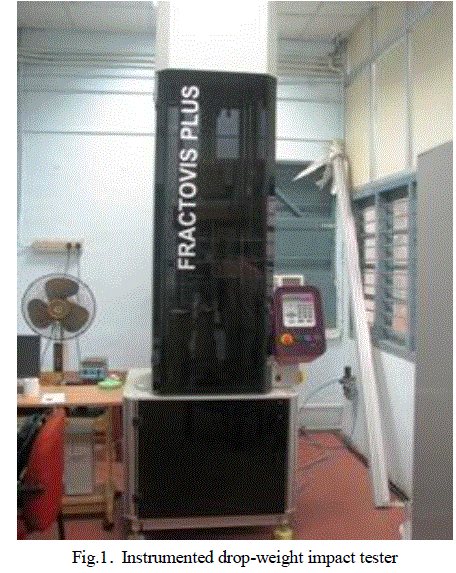 |
III.II TEST SPECIMEN PARAMETERS |
| Test specimens are prepared according to ASTM-D 3029 |
| Material used: Hemp/E-Glass-Epoxy |
| Size of composite specimen: 60×60 mm2 |
| Orientation of layups: [0/90]13 Woven fabric |
| Laminate thickness: 3.6 mm (13 layup) [3] |
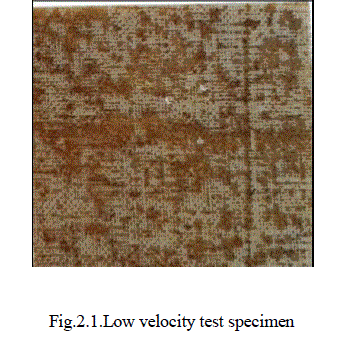 |
IV. RESULTS AND DISCUSSION |
| The impact specimens were subjected to low velocity impact at different impact velocities; 3,4,5 and 6 m/sec. for each impact, the position and acceleration of the impactor were continuously monitored. The incident energy was calculated based on the height history, while the dissipation of energy was derived from both acceleration and height histories of the impactor. A number of tests were performed under varied impact energies ranging from 3.16 to 34.42 J. therefore, in the following, energy profile of the hybrid composite, the load deflection curves and the images of damaged specimens are discussed[5]. Results from the low velocity impact test of hybrid composite of Hemp/E-Glass fiber, are summarized in table 1. |
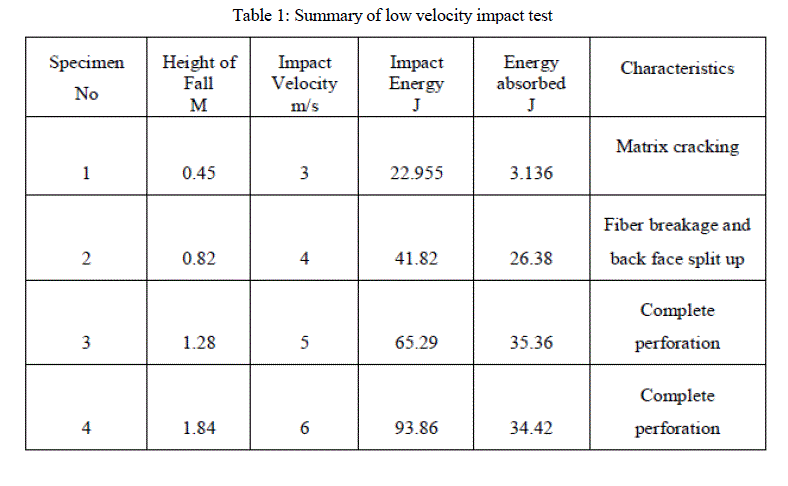 |
IV.I FORCE VS. TIME DISCUSSION |
| Force vs. time curve is obtained for the Hemp/E-Glass-Epoxy specimen for different velocities of 3, 4, 5 and 6m/s. when the tup comes in contact with the specimen first the initial layer gets damaged. Then for fraction of second contact is lost between tup and the specimen. This can be due to the damage of initial layer as so as the next layer comes in contact with the tup again the damage propagates. This goes on till all the energy is used by the specimen. The Fig 3.3.1.Shows Force vs. Time graph. The above curves are obtained for Hemp/ E-Glass Epoxy for a velocity of 3, 4, 5 and 6 m/s. in these curves initially the force is zero when the tap makes contact with the specimen. The non linearity of the curve is due to the micro cracks that are developed due to the impact. From the curve for velocity 3m/s peak load of3760 N is observed at 0.45 milliseconds it is here that the first damage is initiated. Then there is some drop in the curve until the system becomes stable (i.e. when a contact is established again), then there is a sudden drop in the curve, until the next damage again there will be a fall in the curve. Here no complete damage occurs, so very minimum fall in curve is observed. Whereas for curves of 4, 5 and 6 m/s as soon as the curve reaches the peak load we can observe the sudden fall. In these cases complete perforation of the specimens has occurred. |
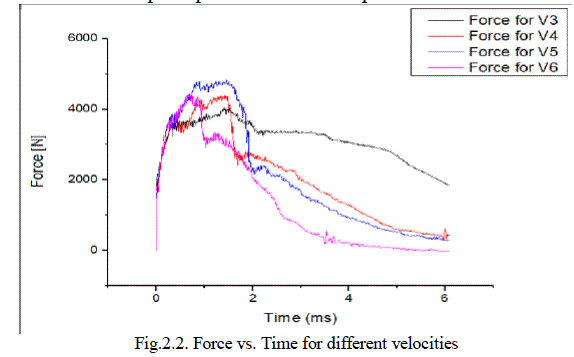 |
IV.II Force vs. Deformation Discussion |
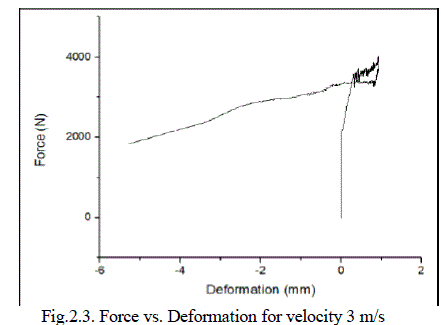 |
| The Fig.2.3 shows Force vs. Deformation graph. The curve is obtained for Hemp/ E-Glass epoxy composite for impact velocity of 3m/s. In this curve we can observe as force increases the deformation increases but at some particular point suddenly force increases without increase in deformation this is due to rebounding of the tup. And finally force drops suddenly without deformation. The Fig.2.4 shows Force vs. Deformation graph[7]. The curve is obtained for Hemp/ EGlass epoxy composite for impact velocity of 4m/s. In this curve we can observe no deformation until force reaches 2000N later deformation slowly increases until it reaches a peak load. Later sudden drop in the load takes place with minimal deformation as it comes in contact with the next layer. Finally load drops slowly with more deformation |
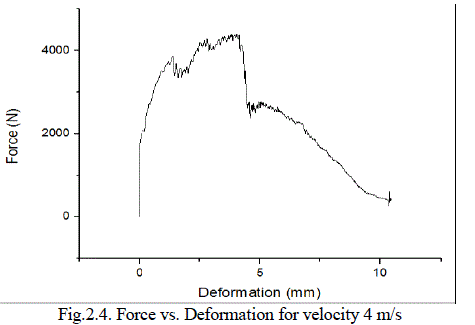 |
| The Fig.2.5 and Fig.2.6 show Force vs. Deformation graph [6]. The curve is obtained for Hemp/ E-Glass epoxy composite for impact velocity of 5m/s and 6m/s. In these curves we can observe no deformation until force reaches 2000N later deformation slowly increases until it reaches a peak load. Later sudden drop in the load takes place with minimal deformation until it comes in contact with the next layer. Finally load drops slowly with more deformation.For a low energy level falling height of 1.84m, impact velocity 6 m/sec, this fiber layout shows good impact velocity resistance characteristics [8]. It evident that clearly two types of failure modes were identified, crack initiation and perforation of the laminate as show in Fig 2.7 |
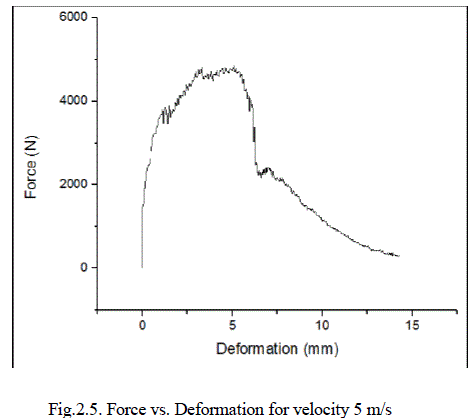 |
V. CONCLUSION |
| The main emphasis of the present work was on development and testing of hybrid hemp and E-glass fabric reinforced epoxy composites to know their suitability and adaptability for various structural applications. Low velocity impact test reveals that prepared hybrid composite is showing very good impact strength up to 22.95J of energy as just matrix cracking is observed at this energy level and further increase in energy has resulted in back face split up and finally perforation. |
References |
|